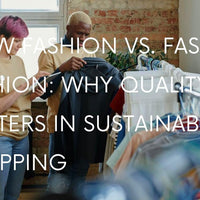With the world’s resources draining faster than ever, it’s an ethical choice for consumers to choose sustainable alternatives. The variables that make a product sustainable can vary—from the packaging of the goods to the materials used to manufacture the item. In fact, the entire supply chain of a product can have different levels of sustainability, and it’s not always possible for consumers to be aware of each step. Fortunately, some companies have direct tells that label them as sustainable, giving you peace of mind knowing where your product falls in the sustainability spectrum. If you want to know the specifics of these tells, as well as other purchasing considerations to make, you’ve come to the right place. In this article, we’ll break down the factors you should know to ensure that you’re making a responsible buying decision for yourself and the environment. Let’s jump right into it.
Before you go to the store or an online shopping site to buy a new product, it’s essential that you have a clear reason as to why you’re buying it in the first place. This philosophy applies even if your product is considered “sustainable”. To uphold sustainable living practices, you need to practice conscious shopping behaviour. Every purchasing decision should be made with a conscious and exact reason. If you buy a product on impulse, you’re prone to using it sparingly and having it eventually become a dust magnet in your home—leading to a needless expending of resources. As such, it’s important to be intentional with what you’re getting. You shouldn’t spend on things just for the sake of spending. The purchase should be done to fix a pressing issue in your current living situation or fulfil a genuine need. Consider all other possible angles before buying something new, and only once you’ve done that and still found the need to purchase a product you’re eyeing, that’s when you can push through with buying it.
Consider Secondhand Purchases
Another factor to consider if you want to uphold positive sustainability practices is buying pre-loved goods.
Buying secondhand items helps bring down the demand for sourcing and manufacturing new goods—which can lead to less raw materials getting transformed into new products.
When done en masse, this can lead to a decreased consumption of the world’s limited resources, giving it some breathing room to naturally replenish its numbers and flourish (or, for non-renewable resources, extra time before it gets completely depleted). While some sustainable products are built within self-sustaining ecosystems, it’s often a safer bet to buy pre-loved items from secondhand sellers instead. This is especially true for items that don’t necessarily need to be bought brand new, like clothing, perfumes, watches, electronics, furniture and more.
By buying pre-loved items, you’re giving items that would otherwise have ended up in landfills gain a new lease on life, thus leading to improved environmental sustainability for all.
Donate The Item You’re Replacing
As mentioned earlier, sustainable living entails mindful buying and making secondhand purchases. But if you’re the person with these items, then you should consider repurposing them for a good cause too.
If you’re buying an item because one of your old ones is worn out, overused, or no longer up to par—but still completely usable—then consider putting the item in a donation drive instead of discarding it into the rubbish pile.
Donating your used items to a charity, local shelter, or donation drive gives them a second life and helps others in need. It also ensures that usable items don’t fill up landfills and are instead still being used with a purpose.
Uphold a Healthy Mind, Body, and Lifestyle
Upholding a sustainable mindset isn’t only about being a smart buyer. It’s also about living healthily and consciously. This means choosing a lifestyle that reflects positively on your body, mind, and soul. As such, be sure to invest in items and services that do your body good. Buy clean, fresh, and quality produce and vegan options when you’re out shopping in the grocery store. Invest in exercise equipment like sustainable yoga mats, vegan running shoes, or a gym membership to enhance your physique. Go on regular medical checkups and book an eye test appointment to improve your health.
By doing all these things, you can prime your mind to be disciplined and less prone to quick rewards. In turn, this can help you transition into a sustainable lifestyle with more ease.
Shop Locally
As much as possible, choose to source products from your city or country. There are several reasons as to why this is optimal for sustainable living. For one, it boosts the local economy. This is especially true if you’re buying items like produce straight from farmer’s markets or furniture made from local stores. Buying locally is also generally cheaper than buying from established businesses that ship to your city. Secondly, shopping locally also reduces your carbon footprint. The overseas product you’re purchasing may have gone through a lot of transportation modes, which can contribute to the emission of greenhouse gasses in the air. Buying locally helps reduce the distance it takes to move the product, thus leading to better environmental benefits overall.
Use Energy Efficient Alternatives
As much as possible, choose items that don’t consume a tonne of energy. While energy doesn’t run out per se, its constant usage can release harmful byproducts and emissions into the air, which is not aligned with sustainable living. At home, consider switching to LED light bulbs instead of more energy-intensive light sources. Find smart appliances that can turn off automatically when not in use. On top of that, be sure to uphold habits that can lower electricity consumption. Close the lights when you’re leaving the room. Avoid letting the TV run unsupervised. Unplug appliances that aren’t in use. By doing these things, you can conserve resources and save costs, which can make for a more eco-conscious lifestyle that’s good for your wallet and the planet.
Look at Certification Labels
Not everyone has the time or availability to determine whether a product is sustainable, and that’s okay. If you’re buying from the shop, the best way to determine whether a product is made sustainably or not is by looking at its certification labels.
In Australian markets, there are a variety of labels that you should look out for, with each having a different set of evaluation criteria based on their regulatory standards. The most common labels are the Australian Certified Organic (ACO) logo, Fairtrade, and Energy Rating labels.
Products with an ACO logo denote that the product is made free from synthetic chemicals, fertilizers, or genetically modified organisms. Fairtrade certification guarantees that the product supports fair wages and working conditions for farmers and workers. The Energy Rating label is given to companies whose products are less energy-intensive than the rest in the market.
Observing these labels can help you pick the most sustainable option in the bunch, giving you peace of mind that you’re buying as sustainable as you can given the information present to you.
Choose Long-Lasting Products
Investing in highly durable products is a smart approach to sustainable living. When choosing durable items, their replacement cycle stretches longer, allowing you to maximise the product’s value over time. This not only saves you money, but it also conserves resources as you don’t need to buy replacements as often—reducing the demand for the product. For instance, buying an expensive shoe for $100 more than a sales rack shoe can actually give you more value in the long run as its lifespan can last two to three years or more. And instead of filling your wardrobe with fast fashion products, opt for sustainable and high-quality wear instead. Buying durable items tends to cost more than buying lower-quality items, so prepare your budget accordingly. That said, they also tend to come with warranties and other guarantees, so they’re often more than worth the price.
We hope this article will help you in your sustainability journey. Good luck buying sustainably!







0 comments